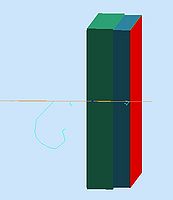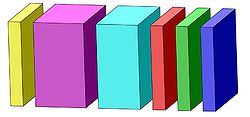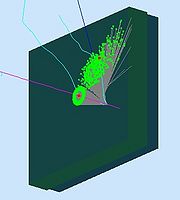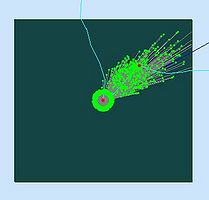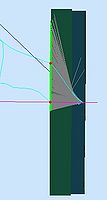Difference between revisions of "MainPage:Nuclear:KaonDetector:Simulations:Codes"
| Line 17: | Line 17: | ||
The parameters that can be specified using the identifiers field are: | The parameters that can be specified using the identifiers field are: | ||
* WithSurface: 1 (0: dielectric_metal; 1: dielectric_dielectric) | * WithSurface: 1 (0: dielectric_metal; 1: dielectric_dielectric) | ||
| − | * | + | * With Finish: 1 (0: polished; 1: ground) |
* Refraction Index: 1030000 (r*1M - this corresponds to 1.03) | * Refraction Index: 1030000 (r*1M - this corresponds to 1.03) | ||
* With Reflectivity: 550000 (R*1M - this corresponds to 0.55) | * With Reflectivity: 550000 (R*1M - this corresponds to 0.55) | ||
Revision as of 10:39, 7 December 2011
| This page is under construction. It requires a review! |
| ⇐ Back to the Kaon Detector page |
General commands
Mirrors
There are two ways to work with mirrors on GEMC. The first one is to define the mirror in the definition of the material, and recompile the GEMC. But the easiest way is to specify the mirror in the "identifiers" field of a geometry definition, in the 'pl' file.
The parameters that can be specified using the identifiers field are:
- WithSurface: 1 (0: dielectric_metal; 1: dielectric_dielectric)
- With Finish: 1 (0: polished; 1: ground)
- Refraction Index: 1030000 (r*1M - this corresponds to 1.03)
- With Reflectivity: 550000 (R*1M - this corresponds to 0.55)
- With Efficiency: 400000 (E*1M - this corresponds to 0.40)
- WithBorderVolume: HTTC (border volume, necessary, must be at the end)
The way to use it in the detector definition is:
$detector{"identifiers"} = "Mirror WithSurface: 1 With Finish: 1 Refraction Index: 1030000 With Reflectivity: 1000000 With Efficiency: 1000000 WithBorderVolume: daughter10";
The code that reads the of the mirror definition of the geometry is inside the MDetectorConstruction.cc. More details in how the GEMC reads these parameters can be understand from looking at this file.
First Simulations on GEMC
For the study of the Kaon Aerogel Cerenkov Detector in the SHMS, some simulations are being prepared using GEMC code. GEMC is a code based on the Geant4.
A first model of the detector was constructed using the standard library of the GEMC, with the standard materials and geometries. The following pictures show this first simplified model of the detector.
Setting the GEMC code to work with material optical properties, a high momentum Pion was generated to pass through the aerogel. The following pictures shows the first results on these simulation. The end plate was set to absorb the photons, so it was possible to see the cone of photons generated by the Cerenkov phenomena.
